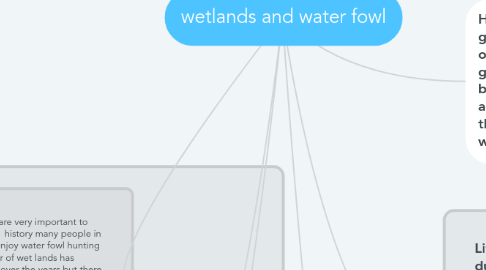wetlands and water fowl
by Ian Prusinski

1. intoduction
1.1. Wet lands are very important to Michigan's history many people in Michigan enjoy water fowl hunting the number of wet lands has decreased over the years but there are still many of them the provide food and a place to live for water fowl and other wetland animals. Water fowl controls wetlands vegetation. Wet lands also reduce flooding for humans as well. in order to be a wet land it has to be covered in water for at least half the year. Wet lands also controls the pollutants in the water.
2. Why wetlands are important They are important because they filter out pollutes in the water and the provide habitat for many of animals and they are good for the water table. they also reduce or stop flooding in some areas. they also produce oxygen they also add recreational or comershal value with ducks geese and fur bearing animals and fish.
3. Threats To Wetlands The biggest threat to wetlands is draining the to turn them into farm fields. there are now laws to stop the draining of wetlands.
3.1. seasonal cycles and seasonal needs in the winter the ducks find an mate in the spring they breed and nest in the summer they raise there young and then in the fall they migrate. Through the year they need different types of food and cover.
4. HISTORY 12000 years ago the glashers came through and dug out rivers and lakes and made good habitat for water fowl the biggest cause of wetland loss is agriculture development now there has been laws to protect the wetlands
5. Life cycles of three common ducks wood ducks live in streams and bottoms that are wooded the feed on acorns they lay there eggs in trees. Blue winged teal live in shallow wetlands they like seasonal wetlands and prefer at lest 8 inches of water. they lay about ten eggs that incubates for 23 days . the mallard is the most extensive of any duck speeches in north america they feed on mesqetoes and dragonfly along with other insects.
6. Management considerations restore water basins, protect habitat and buffers around the habitat, mow the grasses between July 15 and august 30th, manage for large overly mature trees around habitat , keep grass mowed around habitat for the geese, provide supplemental nesting structures, establish a 50 50 mix of mash and open water, you should also minimize the disturbance of humans.


